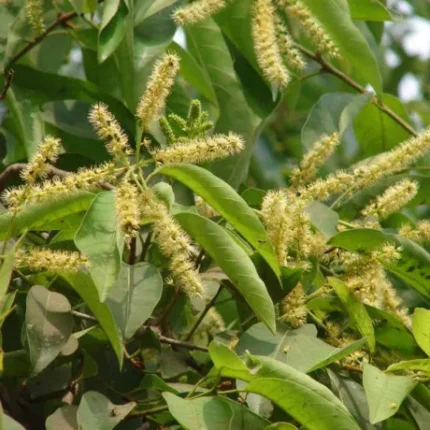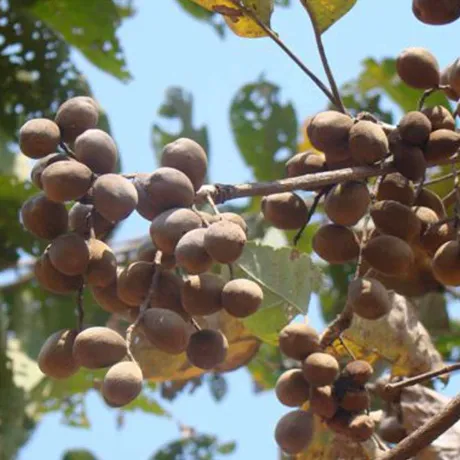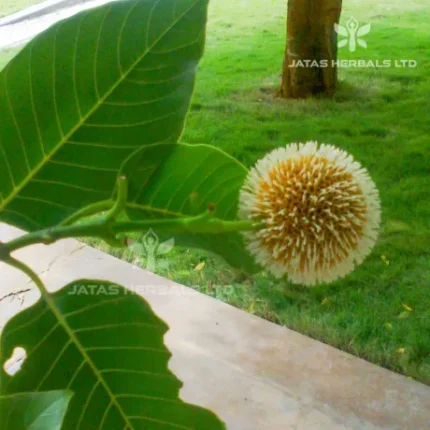Caraka mentioned it under Jvara hara and Kasahara group of durgs. He also indicated it for Rasa, Rakta, Mamsa and Medo vikaras. Sushruta emphasized that it is Madakara while Vagbhata describes it as the best herb for Svasa & Kasa.
Vibhitaki is extensively used in ancient medicine and described by all the Nighantu works. Folk consider its seeds as poisonous. In the recent studies an edible oil is obtained from Vibhitaki seeds justifying the synonym ‘Tailaphala’. Vagbhata described a tincture prepared with Vibhitaki which is known as Akshiki Sura.
Along with Haritaki and Amalaki it forms one of the ingredients of Triphala (three myrobalans).
Botanical Description– It is a large tree, 20-25 m. high, with pubescence on young branchlets. Leaves-Clustered at the end of branchlets, coriaceous, pale beneath, broad elliptic or obovate-elliptic, 8-20 cm long, base often unequal. Flowers- in slender spikas, interrupted, 8-15 cm. long, dirty-grey, or greenish-yellow, with strong, offensive smell. Fruits- ovoid, grey, velvety, with 5 or more less indistinct furrows; nut thick and hard. (Flowers in March-May and fruits in December-February)
Distribution- plains and lower hills throughout India.
Part Used– Fruit rind, seed, seed ighan
Dosage– Powder 3-6 g.
Research works–
(1) out of 93 cases of cough and asthma treated with T. bellerica, 22 showed complete relief, 27 were ighantuyy relieved, while 35 cases were moderately relieved. The drug exhibited branchodilatory, antispasmodic and antiasthmatic activities (Trivedi et al; 1982).
(2) Ethanolic extract of T. bellerica bark showed 60-66% antifertility activity when administered orally at 250 mg/kg dose (sharmal et al; 1983).
(3) Most potent inhibitory activity on avian myeloblastosis virus (AMV)–reverse tanscriptase (RT) was shown by T. bellerica water and methanol extract (Kusumoto et al; 1992).
(4) The HIV-1 protease (PR) inhibitory activity was determined by using the fruit peal methanol extract (Kusumoto el al; 1992, & Valsaraj et al; 1996-97).
(5) T. bellerica showed significant activity against both gram positive and gram negative bacteria. In addition it showed antifungal activity also (Valsaraj et al; 1994).
(6) A significant hepatoprotective effect was observed as evident from shortened hexobarbitone “sleep time” and zaxozolamine “paralysis time” when compared with CCl4 alone. Pre-and post-treatment with the fraction from the fruits of T. bellerica (TB5) reduced, in a dose-dependent manner, the elevated levels of serum transaminases and bilirubin in rats, thus demonstrating its effect both as a prophylactic and curative. Its protective effects on microsomal lipid peroxidation and TGs in liver suggests a restrorative effect in the process of CCl4–induced liver damage. “TB5 did not show any signs of toxicity upto oral doses of 3.2 g/kg in mice” (Anand et al., 1994).
(7) T. bellerica seed oil may become the olive of the East and is fairly abundant in the tropical Indian subcontinent. The raw flesh of the fruit can be converted into fodder. The seed oil content (about 47% by wt. of dry kernel) appears very promising as a vegetable oil for edible purpose and can be hydrogenated or used for soap preparation (Nag & Dc, 1995)







Reviews
There are no reviews yet.